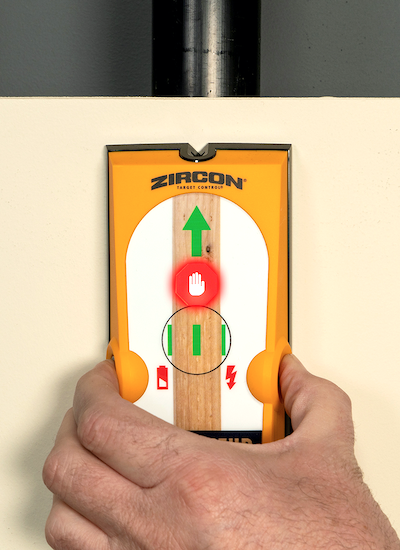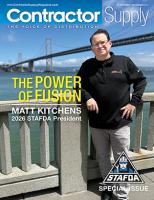Exclusive: The Stud Finder, Reinvented
Advanced second generation stud finder utilizes multiple sensors and sophisticated signal processing to filter out false positives.
 For decades, stud finders have been designed based on capacitive technology that identifies changes in density behind the walls. While this technology can indicate the location of wood stud framing, it also discovers metal, plastic, wiring, and other objects in walls just as easily.
For decades, stud finders have been designed based on capacitive technology that identifies changes in density behind the walls. While this technology can indicate the location of wood stud framing, it also discovers metal, plastic, wiring, and other objects in walls just as easily.
Hypersensitive “deep scanning” modes further increase the potential for “false positives,” objects inaccurately identified as studs. The result is that traditional stud finders frequently chirp or flash LED lights – often to the point of distraction – to indicate something was sensed. But what exactly?
Now new, more advanced technology is being introduced to this popular tool category that promises to redefine and even reset the standards for stud finder performance and accuracy. These next-generation “intelligent” models incorporate multiple sensors and sophisticated signal processing technology to filter out “false positives.”
In doing so, these technologically advanced stud finders locate wood studs – as intended – and also recognize and filter out non-wood objects such as plumbing, conduit, straps, brackets, screws, protector plates, ductwork, plastic pipe, PEX tubing, and wiring behind the walls.
For professionals and DIYers, this innovative technology will provide a more accurate representation of what is behind the wall and significantly improve confidence that what is detected is truly a wood stud. The benefits are significant: minimized rework, less damage created, and increased safety.
And yes, it’s about time.
A common experience
Today, the challenge is only increasing. In addition to metal plumbing and wiring, there is more behind the walls than ever, including network cabling, plastic pipes, and tubing. Complicating matters, wood framing in homes, old or new, can be inconsistent at best. Not all construction follows standard stud spacing practices of 16” or 24” on-center, and there are often additional support beams, fire blocks, and other framing features that can further muddy the picture.
Time and time again, contractors and DIYers often think they’ve found a wood stud only to drill into empty voids or attempt to insert fasteners and meet resistance in the form of false positives, such as copper pipes or metal protector plates. Worse yet, a pop and a spark might indicate the discovery of plastic-sheathed wiring.
The abundance of false positives detected can be frustrating enough that some users opt to leave stud finders in the toolbox in favor of techniques such as rapping on walls or drilling pilot holes.
Still, knowing the location of pipes, wires, and other dangerous obstacles behind the wall is just as valuable as knowing the location of the wood stud. Heavy items need to be mounted securely into the center of studs or they can fall, causing damage or even injury. Likewise, drilling into water lines can lead to costly repairs, and attempting to insert fasteners through live electrical wiring can result in significant safety issues.
For professionals and DIYers alike, the consequences can be considerable rework, loss of time, and decreased productivity.
Innovation in the Stud Finder Category
Today, basic models at varying price points are available from big name brands better known for products in other tool categories.
Zircon Corporation, however, has been in the stud finder game for more than 40 years. In 1980, the company manufactured the original StudSensor™ stud finder and invented the category. The Silicon Valley-based company produces more than just stud finders, to be clear. They design and manufacture an extended range of sensor technologies in electronic hand tools spanning wall scanners, metal detectors, circuit breaker finders, drill guides, water detectors, and leveling tools.
With this background, the company continues to lead the path to innovation in the category. The latest invention is Wood Stud SuperScan® with Target Control® Technology + FILTERz™. By analyzing the complex data streams from multiple sensors and controlling the result using sophisticated intelligence, the stud finder finds wood studs and filters out metallic objects, such as plumbing, conduit, straps, brackets, screws, protector plates, or ductwork in the wall. Additionally, the technology alerts the user to the presence of other low signal-strength, non-metallic targets, like plastic pipe, PEX tubing, and wiring.
To simplify the delivery of this seemingly complex information to users, Zircon invested extensive time and research to understand the user experience. A new and improved user interface provides an intuitive “go/no go” indication in response to what is being sensed. With a new haptic vibration and a patented SpotLite® Pointer that shines an arrow-shaped beam on the wall, users can clearly understand the target’s location and areas to avoid.
By filtering out false positives, users can be confident they have located a wood stud and not something else. Given the opportunity for a much clearer picture of what is behind the wall, contractors and DIYers would do well to upgrade their existing stud finder with an affordable, next-generation model that is sure to become the new standard in scanning. It would be the “intelligent” decision.
For more information, call Zircon Corporation at (408) 963-4550, e-mail: info@zircon.com, or visit www.zircon.com.
















